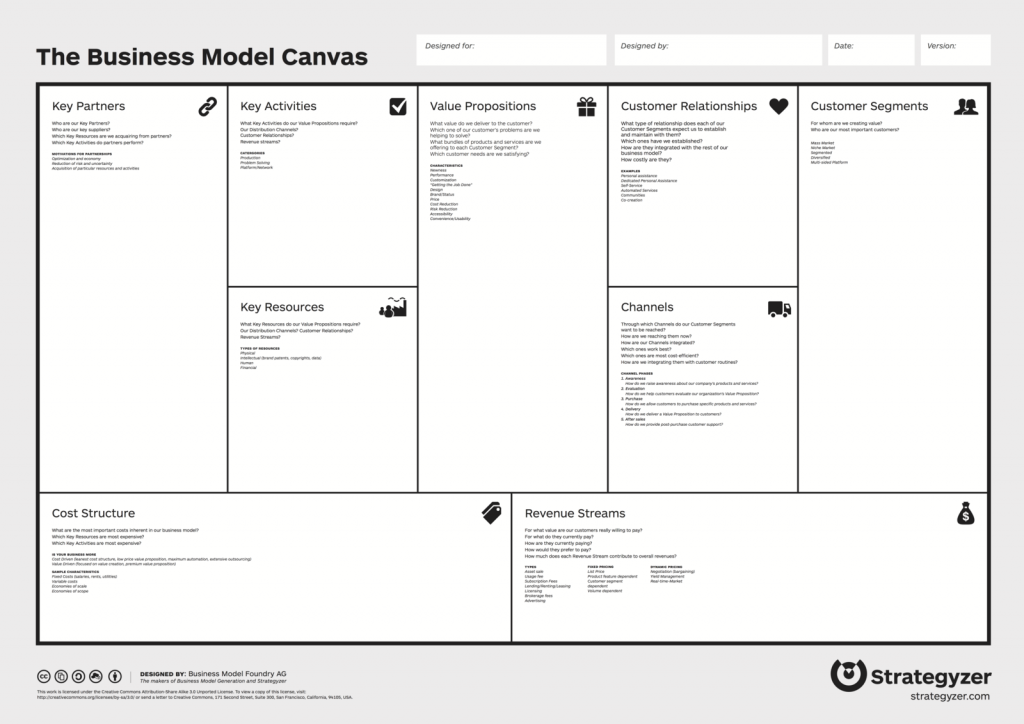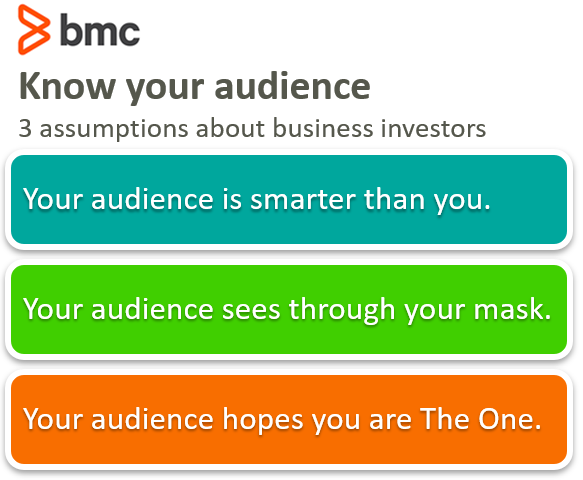Every company is a story. Anyone looking to invest in a company will need to know this story. The Business Model Canvas is one popular format for presenting your company’s story. Let’s take a look.
A canvas for your business model
Your company story isn’t a marketing ploy: it does not need to be new, innovative, or made-up. In fact, you already have your company story—it’s your business model. The business model canvas is one framework for sharing your story, or business model, with potential investors.
This strategic management framework was first developed by Alexander Osterwalder in the mid-2000s. While the original canvas is applicable to any business, regardless of size, history, or budget, additional canvases have popped up in various niches.
The simplicity of the business model canvas is what makes it so successful. The canvas is plain, looking much like a billboard or whiteboard. It’s comprised of nine criteria that express the important character traits for your business’ story, ranging from who you know to how you make money to what you have. The canvas acts as an advertisement to attract business investors or other founders.

There are several benefits of using this framework:
- Simplicity. This single, straightforward sheet means there’s no filler. Your canvas highlights the basics of your business, so you should already know the answers to most of these. The compiling of information might be overwhelming, but the business model canvas ensures a simple process.
- Customer focused. Your canvas shows how you think about and interact with your customer, and it can help expose any weaknesses.
- For any company. Whether you’re a one-person start up or part of a multi-national company, the business model canvas works.
Know your audience: 3 business model canvas tips
Before we explore the nine criterion of your canvas, it’s important to consider your audience when creating a canvas. Your audience is potential investors, and these three tips will help strengthen your business model canvas.

When creating a canvas, you should assume these things about your audience:
- They are smarter than you. Be clear, be concise. There is no reason for great exposition. This is a place to create a bullet point list for the reasons why you’ll succeed. Let the audience see the data and piece it together.
- They see through your mask. There is a little room for embellishment—after all, you want to stand out. But too much embellishing can kill a project because your audience can see it. There is a fine line between confidence and foolishness, and if you can’t tell the difference, stick to talking straight.
- They hope you are The One. Your audience wants, more than anything, for you to succeed. They want to find a good match. They do not take the time to listen and read these just because they enjoy critiquing everything that passes over their desk. They enjoy the thrill of finding The One.
9 criteria of the business model canvas
The nine criteria are subsets of four major categories in the business model canvas:
- Infrastructure
- Offering
- Customers
- Finances
Each major category is comprised of one or a few criterion.
Infrastructure
This section is all about the things you need—people, processes, technology, and partners—to run your business.
- Key activities. What does your business do? Are you managing large software teams? Do you have to manage a large supply chain? These are activities essential to the business. If your business is a salon, for examples, your key activities might be hiring and training staff, cutting and styling hair, opening and closing the shop, sending emails and offers, and making thank you cards to improve customer relations.
- Key resources. These are the things you need to perform your key activities, in order to create value. The key resources of a salon are staff, a physical location, marketing, and customers. Which resources do you have that are unique to you and give you an advantage? It might be an excellent 3-year contract on a prime downtown property because its owner had to sell quickly. It could be that you get discounted hair products from the manufacturer because you worked there for 15 years or negotiated a deal.
- Partner network. These are people in your network who can help you. People reading your business model canvas like to see that you are not a lone wolf, starting from scratch. They want to see you have support. They want to see that they are not the only ones who are signing up to help your business succeed. The partner network is the place to brag about who you know. These can be team members, suppliers, marketing avenues, etc. Anyone who is on board to contribute to the business.
Offering
This section explores the value you offer.
- Value proposition. Your value proposition is the most important component of any business. Why are you valuable? If the business provides no value, then, why? Why should anyone buy into it? Why should anyone support it? Why does anyone need it? This value needs to be directed at who your business serves in the marketplace. The proposition is not why you are valuable to the readers and the investors. The value needs to be directed at who your business targets. Google helps people find things they wish to know. Apple makes elegant, simple products designed to work out of the box. Your salon cuts and styles people’s hair.
Customers
This section is all about your customers: whether, where, and how you talk to them and they buy from you.
- Customer segments. These are the people to purchase your product. It is helpful to think of your first customer. In the end, you may want everyone to be a customer, but, right now, who will be the first person to buy your product? Customer segmentation can be categorized by demographic, geography, social class, financial class, personalities, etc.
- Channels. How do you meet your customers? Do you go to them? Do they come to you? Channels could be Twitch.tv for a media platform. It could be a writing contest for a Hack-A-Thon. It could be the business location for a coffee shop. It could be a website for a microservice. It could be engineers’ Twitter accounts for any software company. The channel is a pathway of communication that links a community to the business.
- Customer relationships. What kind of relationship do you want to have with your customer? What is the relationship’s nature? Transactional, personal, automated, self-service, community oriented. A vending machine is self-service. Major cloud providers are mostly self-service. They lack in support so much that other companies can be built entirely around providing customer service for their platform. Other cloud providers are popping up, too, whose business’ value proposition is that they have phone-call customer service—a unique value for certain categories of customers.
Finances
The finances section really wants to know your income statement. What are your costs and how do you bring in money?
- Cost structure. What are your company’s costs? Income statements do a good job of putting expenses into operating expenses and capital expenses, and that can serve as a good model for this part of the canvas. Operating expenses are the day-to-day costs of doing business. At the salon, it would be largely labor costs for hiring stylists to cut hair. Capital expenditures would be costs associated with stocking shelves with hair products, rent costs, and electricity costs.
- Revenue streams. Finally, how does your company make money? The salon makes money by cutting and styling hair. They maintain a register to sell hair products. Maybe they create distinctions in their stylist offerings and do normal cuts, styled cuts, perms, colorings, and events like weddings or model shoots.
Spend some time on the canvas: make it flow, edit each section, and present your company with a complete story.
Additional resources
For more on strategic business planning and aligning technology to your business, browse our BMC Business of IT Blog or check out these articles:
- What Is “IT-Business Alignment”?
- Introduction to Business Process Management (BPM)
- Why Business Value is Key to IT Success
- What is Technology Business Management? TBM Explained
- Business Capability Mapping
These postings are my own and do not necessarily represent BMC's position, strategies, or opinion.
See an error or have a suggestion? Please let us know by emailing blogs@bmc.com.






